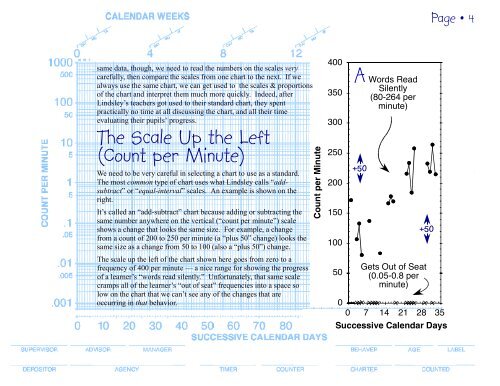The Chart Book
The Chart Book
The Chart Book
You also want an ePaper? Increase the reach of your titles
YUMPU automatically turns print PDFs into web optimized ePapers that Google loves.
same data, though, we need to read the numbers on the scales very<br />
carefully, then compare the scales from one chart to the next. If we<br />
always use the same chart, we can get used to the scales & proportions<br />
of the chart and interpret them much more quickly. Indeed, after<br />
Lindsley’s teachers got used to their standard chart, they spent<br />
practically no time at all discussing the chart, and all their time<br />
evaluating their pupils’ progress.<br />
<strong>The</strong> Scale Up the Left<br />
(Count per Minute)<br />
We need to be very careful in selecting a chart to use as a standard.<br />
<strong>The</strong> most common type of chart uses what Lindsley calls “addsubtract”<br />
or “equal-interval” scales. An example is shown on the<br />
right.<br />
It’s called an “add-subtract” chart because adding or subtracting the<br />
same number anywhere on the vertical (“count per minute”) scale<br />
shows a change that looks the same size. For example, a change<br />
from a count of 200 to 250 per minute (a “plus 50” change) looks the<br />
same size as a change from 50 to 100 (also a “plus 50”) change.<br />
400<br />
350<br />
300<br />
250<br />
200<br />
150<br />
100<br />
<strong>The</strong> scale up the left of the chart shown here goes from zero to a<br />
frequency of 400 per minute — a nice range for showing the progress<br />
50<br />
of a learner’s “words read silently.” Unfortunately, that same scale<br />
cramps all of the learner’s “out of seat” frequencies into a space so<br />
low on the chart that we can’t see any of the changes that are<br />
occurring in that behavior. 0<br />
A<br />
+50<br />
Words Read<br />
Silently<br />
(80-264 per<br />
minute)<br />
Gets Out of Seat<br />
(0.05-0.8 per<br />
minute)<br />
+50<br />
0 7 14 21 28 35<br />
Successive Calendar Days<br />
Page • 4


